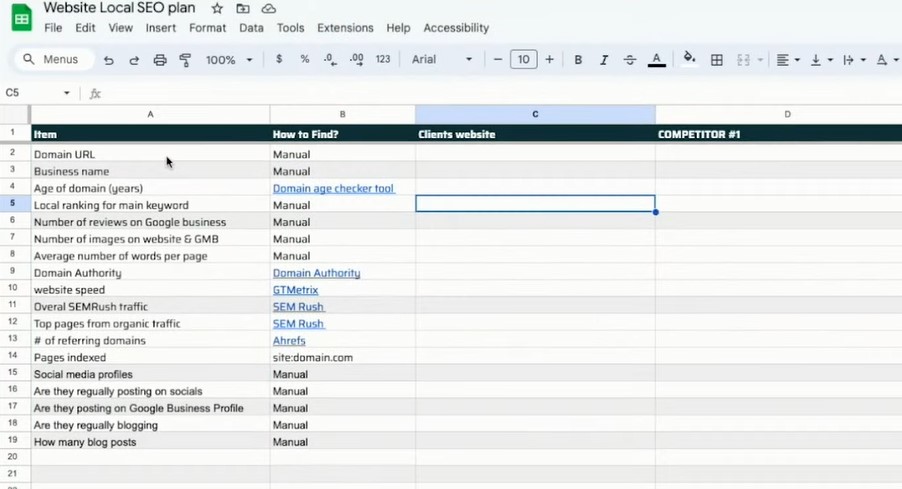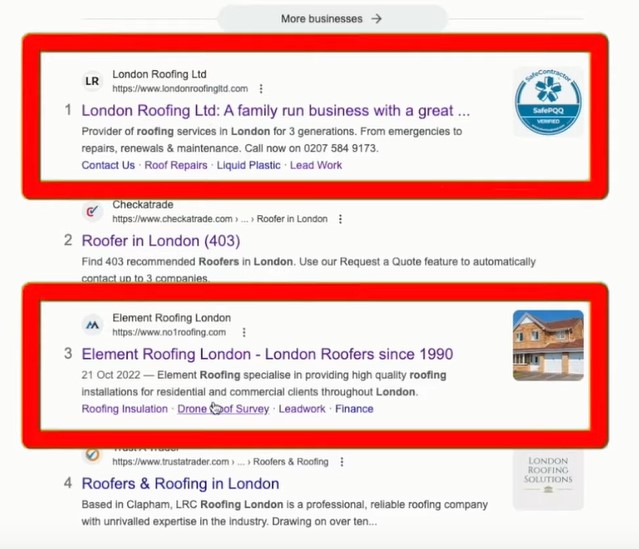
When it comes to local SEO, figuring out how to outrank your competitors can feel like trying to solve a puzzle without all the pieces. But what if you could peek at your competitors’ strategies and use them to your advantage? That’s exactly what we’re going to do today. In this guide, we’re diving into a step-by-step competitor analysis to uncover what’s helping them rank high on Google and more importantly, how you can do it even better.
Whether you’re running a roofing business, a plumbing service, or any other local service business, understanding and improving upon what your competitors are doing can be the key to rapidly boosting your website’s visibility and ranking on the first page.
These are the exact strategies we use to carry out competitors analysis for our clients and get their website on the first page of google.
How to do Competitor Analysis?
Competitor analysis is more than just checking out what others in your industry are doing. It is about dissecting their strategies, understanding their strengths, and learning from their mistakes. When you analyse competitors who are ranking well on Google, you gain insights into the tactics that are working in your industry and also see where you are lacking.
By replicating and enhancing these strategies, you can improve your own site’s ranking, driving more local customers to your business.
Step 1: Preparing Your Competitor Analysis Tool
Before diving into the intricacies of competitor analysis, it’s important to set up a systematic way to gather, organise, and analyse data. For this, you’ll need a tool that allows you to capture various SEO metrics like competitor backlinks, common keywords, etc. and compare them side-by-side. A Google Sheet is perfect for this purpose.
Here’s how you need to prepare your Google Sheet for competitor analysis: (complete video is added at the end)
Create a New Google Sheet

-
- Naming Your Sheet: Start by creating a new Google Sheet and give it a clear, descriptive name, such as “Local SEO Competitor Analysis.” This will help you easily identify it in your Google Drive and keep your SEO efforts organised.
-
- Structuring the Sheet: Your Google Sheet should be structured to allow for easy comparison between your website and your competitors. You’ll want to have separate columns for each metric you’ll be analysing, such as:
-
- Business Name
-
- Domain Age
-
- Local Keyword Rankings
-
- Google My Business Reviews
-
- Google My Business Images
-
- Average Words Per Page
-
- Domain Authority
-
- Website Speed (Mobile and Desktop)
-
- SEMrush Traffic
-
- Top Ranking Pages
-
- Referring Domains
-
- Pages Indexed
-
- Social Media Presence
-
- Posting Frequency on Social Media
-
- Google Business Profile Activity
-
- Blogging Frequency
-
- Structuring the Sheet: Your Google Sheet should be structured to allow for easy comparison between your website and your competitors. You’ll want to have separate columns for each metric you’ll be analysing, such as:
Set Up the Columns and Rows
-
- Column Headers: In the first row of your sheet, label each column with the specific metrics you will be analysing. For example, the first column should be labeled “Metric,” the second “Client Website,” and the third and fourth could be labeled with the names of your competitors.
-
- Rows for Data Entry: Below each column header, create rows where you can input data for each metric. This will allow you to compare your performance against each competitor in a clear and organised manner.
Step 2: Identifying Competitors and Gathering Initial Data
Once your Google Sheet is ready, the next step in the competitor analysis process is to identify your main competitors and gather the initial data needed for comparison
Identify Your Competitors

Start by identifying your direct competitors; these are businesses that offer the same products or services as you within the same geographic area. For example, if you run a roofing company in London, your direct competitors would be other roofing companies operating in the same city.
So for instance, start by searching for your primary keyword, such as “roofing London,” in Google. Then select the top businesses that are showing up in the organic listings for this search.
Step 3: Analysing Key Metrics
This step involves collecting various data points and recording them in your google sheet. This will tell you how well your competitors are performing in local SEO. By understanding these metrics, you can identify gaps in your own strategy and find opportunities to outperform your competitors. Here’s a detailed look at each key metric you should analyse:
Business Name
This is really straightforward, record the business names of your top competitors. Understanding who your direct competitors are is crucial, as it helps you focus your analysis on the right players in your industry.
Age of the Domain
The age of a domain refers to how long a website has been active. Google often favors older domains because they are seen as more established and trustworthy. Use tools like WHOIS or domain age checkers to find out how old your competitors’ domains are.
Why It Matters: An older domain typically has more backlinks, content, and authority, making it easier to rank higher in search results. However, even if your domain is newer, you can still compete by focusing on building quality content and gaining backlinks.
Local Ranking for Main Keywords
Keywords are the foundation of SEO. Identify the main keywords your competitors are ranking for, especially in the local context. Tools like SEMrush or Ahrefs can help you uncover which keywords are driving traffic to your competitors’ sites.
Why It Matters: By understanding which keywords your competitors rank for, you can identify gaps in your own keyword strategy. Targeting the right keywords can help you rank higher in local searches and attract more relevant traffic.
Number of Reviews on Google My Business
Google My Business (GMB) reviews are a critical factor in local SEO. Check how many reviews your competitors have on their GMB profiles. Click here to know how you can get more positive reviews on Google.
Why It Matters: Reviews are a significant trust signal for both Google and potential customers. More positive reviews can improve your rankings in local search results and encourage more customers to choose your business over others.
Number of Images on Google My Business
Images on your GMB profile can enhance your listing and make it more attractive to potential customers. Count the number of images your competitors have uploaded.
Why It Matters: Google rewards active and well-maintained GMB profiles. Regularly uploading images not only improves your GMB profile’s appearance but also contributes to better local search rankings.
Average Number of Words Per Page
Content length can be an important factor in SEO. Analyse the average number of words per page on your competitors’ websites.
Why It Matters: Pages with more in-depth content often rank higher because they provide more value to users. If your competitors are ranking with longer content, consider expanding your own pages to match or exceed their word count while ensuring quality.
Domain Authority
Domain Authority predicts how well a website will rank on search engine result pages.
You can use tools like Moz, Ahrefs, or SEMrush to check the Domain Authority of your competitors’ websites.
Why It Matters: A higher domain authority usually correlates with better rankings. If your competitors have higher Domain Authority, it means they have more high-quality backlinks and possibly better content. You’ll need to focus on building your own authority through link-building and content building.
Website Speed
Website speed is a critical ranking factor, especially for mobile searches. Use tools like Google PageSpeed Insights to analyse the loading speed of your competitors’ websites.
Why It Matters: Faster websites provide a better user experience and are more likely to rank higher on Google. If your competitors’ websites load faster, you should take steps to optimise your site’s speed to stay competitive.
Overall SEMrush Traffic
SEMrush can provide an estimate of the monthly organic traffic your competitors receive. While these numbers are approximations, they can give you a sense of how much visibility your competitors have.
Why It Matters: Higher traffic often means more leads and conversions. By understanding your competitors’ traffic, you can set benchmarks for your own SEO efforts and identify areas where you can capture more market share.
Top Pages from Organic Traffic
Identify which pages on your competitors’ sites are driving the most organic traffic. SEMrush or Ahrefs can show you the top-performing pages for any given website.
Why It Matters: Knowing which pages are most successful can help you identify content gaps on your own site. You can create similar pages that target the same keywords or topics to capture some of that traffic.
Referring Domains
Referring domains are websites that link back to your competitors’ sites. The more referring domains a site has, the higher its potential authority.
Why It Matters: Backlinks from reputable sites improve your site’s authority and ranking. By analysing your competitors’ backlinks, you can identify opportunities to build your own links on similar domains.
Pages Indexed
Check how many pages Google has indexed for your competitors. You can do this by searching “site.com” on Google.
Why It Matters: The number of indexed pages can give you an idea of how much content your competitors have. More indexed pages mean more opportunities to rank, so if your competitors have significantly more pages indexed, you may need to increase your content production.
Social Media Profiles
Social media plays a supporting role in SEO by driving traffic and building brand awareness. Note which social media platforms your competitors are active on and how they engage with their audience.
Why It Matters: An active social media presence can enhance your SEO efforts by driving traffic to your site and building a loyal following. If your competitors are active on platforms where you are not, consider establishing a presence there.
Regularly Posting on Social Media
It’s not enough to have social media profiles; regular posting is crucial. Check how often your competitors post and what type of content they share.
Why It Matters: Consistent posting keeps your brand visible and can drive consistent traffic to your site. If your competitors post regularly and you don’t, they might be engaging their audience better and driving more traffic.
Posting on Google Business Profile
Google Business Profile allows businesses to post updates, offers, and news directly on their profile. Check if your competitors are taking advantage of this feature.
Why It Matters: Regularly posting on your Google Business Profile can improve your local search rankings and keep your audience informed. If your competitors aren’t doing this, it’s a missed opportunity that you can capitalise on.
Regularly Blogging
Blogging is a powerful tool for SEO, especially for targeting long-tail keywords and providing valuable content to your audience. Check if your competitors are blogging regularly and what topics they cover.
Why It Matters: Regular blogging can improve your website’s authority and bring in more organic traffic. If your competitors are not blogging, this is an opportunity for you to gain a competitive edge by providing valuable content.
Number of Blog Posts Published
Count the total number of blog posts your competitors have published. This gives you an idea of their content strategy.
Why It Matters: A higher number of blog posts indicates a strong content marketing strategy. If your competitors have significantly more blog posts, you may need to ramp up your content production to compete effectively.
Once you’ve gathered all the data, fill out your Google Sheet with the details. For each metric, compare your site with your competitors and identify areas where you’re lagging. This will help you create a clear roadmap for improvement.
Step 4: Creating an Action Plan
Now that we have gathered all the essential data from our competitor analysis, it’s time to put this information into action. Creating a well-structured action plan is crucial for systematically addressing the areas where your website falls short compared to your competitors. This step will guide your efforts to optimise your website, improve its ranking, and ultimately drive more local traffic.
Prioritise Key Areas of Improvement
First, review the data you’ve collected and identify the most critical areas that need immediate attention. These areas could include:
-
- Keyword Optimisation: If your competitors are ranking for specific high-traffic keywords that you’re not targeting, make this a priority. Start by optimising existing pages with these keywords or creating new pages specifically designed to target them.
-
- Content Enhancement: If your competitors have longer, more detailed content, plan to expand your existing content. This could involve adding more text, incorporating visual elements like images and videos, or including more informative sections like FAQs or case studies.
-
- Backlink Strategy: If your competitors have a significantly higher domain authority due to more backlinks, create a plan to build high-quality backlinks. Focus on getting listed in niche directories, reaching out to local businesses for partnerships, and creating shareable content that naturally attracts links.
-
- Google My Business Optimisation: If your competitors have more reviews, images, and posts on their Google My Business profiles, prioritise increasing your activity here. Encourage satisfied customers to leave reviews, regularly update your profile with new images, and start posting updates or promotions weekly.
-
- Social Media Presence: If your competitors are more active on social media, create a content calendar to ensure consistent posting across all relevant platforms. This will help build brand awareness, engage your audience, and signal to Google that your business is active and credible.
Set Specific Goals
-
- Increase Domain Authority by X: Establish a realistic goal for improving your domain authority, such as increasing it from 5 to 15 within 2 months. Break down this goal into smaller tasks, like acquiring a specific number of quality backlinks each month or publishing a certain number of high-authority guest posts.
-
- Achieve Top 3 Rankings for X Keywords: Choose a set of high-priority local keywords and set a target to rank within the top 3 results on Google for these keywords within a specified timeframe. Monitor your keyword rankings regularly and adjust your content and SEO strategies based on performance.
-
- Gain X Number of Reviews on Google My Business: Set a target for the number of new reviews you aim to receive on your Google My Business profile each month. Ideally you want to have the highest amount of reviews on your google profile. So, create a system for following up with customers after service completion, requesting reviews, and offering incentives if necessary.
Prioritise Tasks Based on Impact
-
- Immediate Impact Tasks: Focus first on tasks that will deliver quick wins, such as optimising existing content with targeted local keywords, speeding up your website’s load time, and adding more images to your Google My Business profile. These changes can lead to faster improvements in your search engine rankings and local visibility.
-
- Long-Term Strategies: While some tasks may not have an immediate effect, they are really important for ranking your website on the first page. These include building high-quality backlinks, increasing domain authority, and regularly publishing blogs to establish your website as an authority in your niche. These tasks should be scheduled over the coming months to ensure consistent progress.
-
- Resource Allocation: Determine which tasks can be completed in-house and which ones might require external help. For example, you might need to hire a content writer to produce regular blog posts or an SEO specialist to handle technical optimisations.
Below is the complete video guide –
Conclusion
Competitor analysis is an essential step in any local SEO strategy. By understanding what your competitors are doing well and where they’re falling short, you can refine your own approach and achieve better rankings on Google. Remember, the key is not just to replicate what others are doing, but to improve upon it. With a well executed competitor analysis and a solid action plan, you’ll be well on your way to dominating local search results and driving more customers to your business.
So, grab your Google Sheet, start analysing, and watch your local SEO efforts pay off.

Speak with our SEO Expert
Got a quick question about how your small business can grow
with perfect SEO strategy? Ask our expert.
Speak to one of our experts today on 01702 668207 or send us a message.
